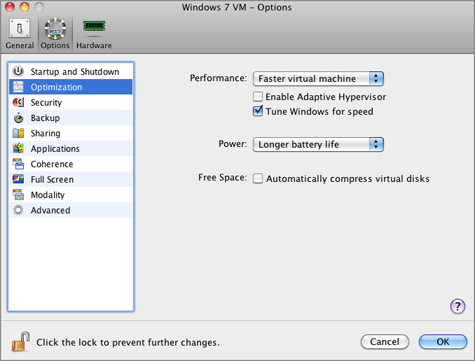Optimization Settings
Using the Optimization settings, you can optimize your virtual machine performance.
To edit these settings, do the following:
- Open the Virtual Machine menu or Alt-click (Option-click) the Parallels icon in the Mac menu bar (in the Crystal view mode) and click Configure .
- In the Virtual Machine Configuration window, click Options and select the settings name in the sidebar.

Optimizing Performance
The Performance option defines the priority of distributing the main physical computer memory resources:
- Click the Performance field and select Faster virtual machine to allocate more physical computer memory resources to the virtual machine and its applications. Selecting this option may significantly increase the virtual machine performance; however, it may slow down the productivity of your Mac OS X applications.
- Click the Performance field and select Faster Mac OS to allocate more memory resources to the physical computer and its applications. In this case, the memory resources usage will be optimized to provide better performance of your Mac OS X applications.
Using Adaptive Hypervisor
Select the Enable Adaptive Hypervisor option to automatically allocate the host computer CPU resources between the virtual machine and Mac OS X applications depending on what application you are working with at the moment. If your virtual machine window is in focus, the priority of this virtual machine processes will be set higher than the priority of the Mac processes. As a result, more CPU resources will be allocated to the virtual machine. If you switch to the primary OS window - the priority of its working applications will be set higher and the CPU resources will be relocated to Mac OS X.
Tuning Windows for Speed
You can make your Windows virtual machine work even faster by selecting Tune Windows for speed . This option disables some of the additional Windows features that tend to slow down the Windows performance.
Optimizing Power Consumption
The Power option allows you to control the virtual machine power consumption when Parallels Desktop is installed on a Mac laptop computer that is running on batteries (for example, MacBook Pro):
- If you select Longer battery life in the Power field, the virtual machine power consumption will be automatically reduced to provide a longer life for your Mac laptop battery.
- If you select Better performance , the virtual machine and its applications will operate at the maximum possible speed. However, enabling this option may significantly reduce your Mac laptop battery life.
If you select the Show battery in Windows option (or Show battery in Linux for Linux virtual machines), the battery status will be displayed in your virtual machine each time your Mac laptop computer runs on batteries. This option is available only on laptop Macs.
Compressing the Disk Automatically
If you use an expanding virtual hard disk in your virtual machine, its image file size on the physical hard disk increases as you add new data to the virtual hard disk. When you delete some data from this virtual hard disk, free unused space appears on the disk but the amount of space your virtual machine occupies on the hard disk of your Mac does not reduce. To regularly free the unused space back to Mac, use the Automatically compress virtual disks option. The virtual hard disk in an expanding format will be reviewed twice a day and, if the unused space occupies more than 50 percent of the hard disk image size, it will be compressed and the hard disk image file size will be decreased. As a result, there will be more free space on your Mac hard disk.
Note: Compressing can be performed for virtual machines without snapshots and with the Undo disks option disabled.
In the Hard Disk pane , you can compress the disk manually whenever you want.
If you want to prevent Virtual Machine Configuration from unauthorized changes, click the Lock icon
![]() at the bottom of the window. The next time someone wants to change the settings in any pane of Virtual Machine Configuration, an administrator's password will be required.
at the bottom of the window. The next time someone wants to change the settings in any pane of Virtual Machine Configuration, an administrator's password will be required.
|
|
 Feedback
Feedback
|